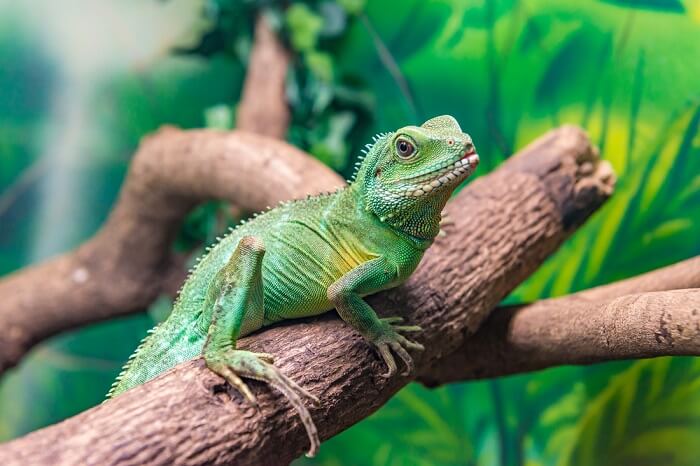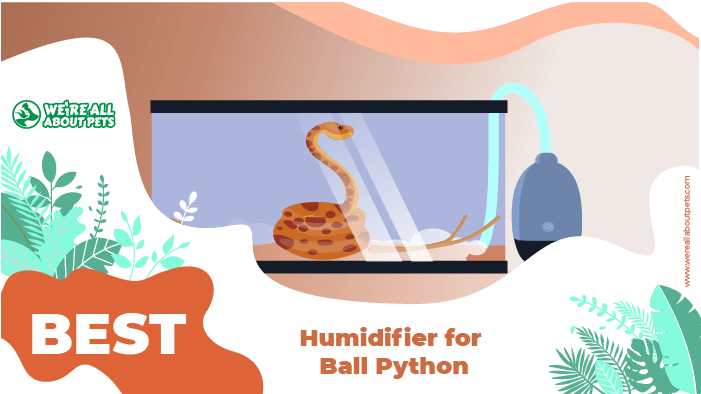How To Care For A Bearded Dragon?
This page contains affiliate links. We may earn money or products from the companies mentioned in this post through our independently chosen links, which earn us a commission. Learn More
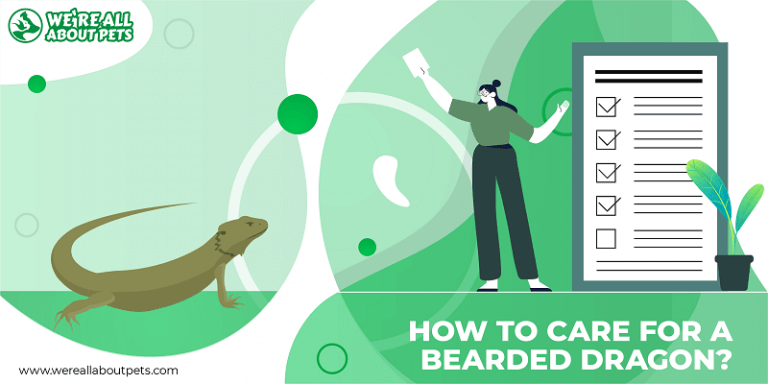
General Stats:
- Pet Type: Reptile
- Size: 18 to 24 inches
- Diet: Omnivore
- Lifespan: 8 to 15 years
Bearded dragons make wonderful pets, especially if you’re new to reptile care. These reptiles may look a bit intimidating because they have spikes on their bodies, but the spikes are actually quite soft and beardies (as they’re affectionately nicknamed) are easy to train and can be very gentle.
As is true for any pet, it’s important to learn the basics of bearded dragon care before you settle on one as your next pet. Here’s your essential bearded dragon care guide with everything you need to know about these pets and how to prepare for owning one.
Habitat Setup For Bearded Dragons
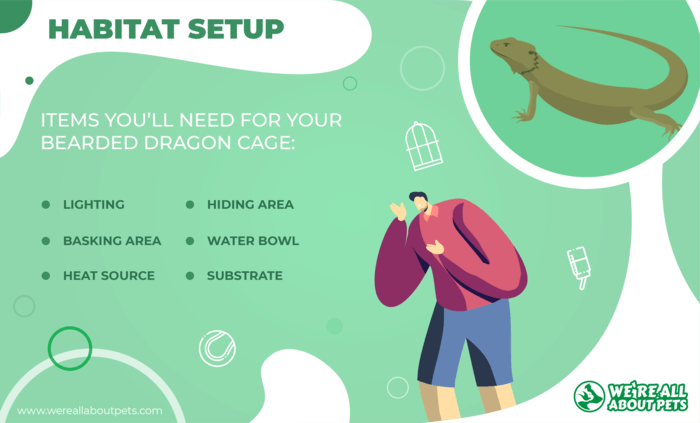
The first thing you need before bringing a new bearded dragon home is a suitable habitat. Many reptile owners choose a terrarium or vivarium specifically designed for reptiles rather than a solid glass fish tank. The benefit of these habitats is that they provide some ventilation and better access.
In terms of terrarium size, hatchlings can be kept in a 20-gallon tank, but you’ll need a 40-gallon tank or terrarium for an adult bearded dragon. The larger the tank the better, especially if you’re keeping a pair.
Here are some of the items you’ll need for your bearded dragon cage:
- Lighting – Some reptiles like bearded dragons need both UVA and UVB lights, so make sure the daylight bulb in your tank is full-spectrum. Bearded dragons need UVB to be able to synthesize vitamin D3 which helps them absorb calcium from food. The light should be replaced every 6 months to ensure a good UV source.
- Basking Area – In addition to UV light, your bearded dragon needs a basking spot where he can warm up. A basking light should be placed over a flat area where your new pet can stretch out.
- Heat Source –Bearded dragons need a temperature gradient that goes from 75 to 85 degrees Fahrenheit to 90 to 100 degrees Fahrenheit in the basking zone. A heating pad under the tank is a good way to maintain the ideal ambient temperature, though ceramic heat emitters work too.
- Hiding Area – In addition to a basking area, your bearded dragon may appreciate having a cooler space he can go to hide and sleep. Hiding areas should be provided in both the warm and cool ends of the enclosure.
- Substrate – It’s a good idea to line your bearded dragon cage with some kind of bedding or substrate to keep it comfortable and to make cleaning easier. Reptile carpet is a simple choice, though you can also use something simpler like paper towels. If you want something naturalistic, then rocks or a solid clay material are a good choice.
- Water Bowl – Though your bearded dragon may get most of his water from his diet, you should provide a water dish for soaking and additional hydration. The water bowl will also help maintain tank humidity levels, though you should keep a hygrometer to check that it stays within the ideal range of 30% to 40%.
In addition to choosing the right equipment for your bearded dragon’s enclosure, you should also think about where to put it. The best option is to put it somewhere you won’t have to worry about direct sunlight or air vents affecting the temperature – maintaining stable tank conditions is important for your pet’s well-being. It shouldn’t be in a high-traffic area either.
Bearded Dragon Diet
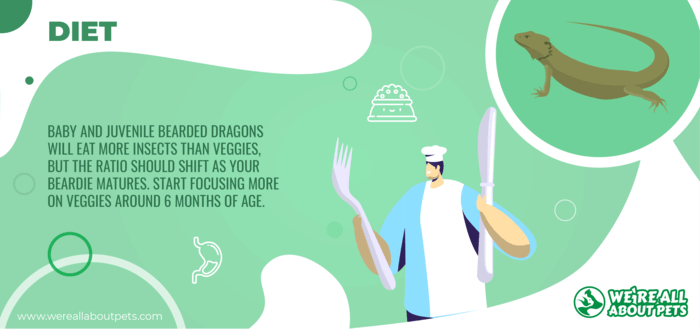
Providing a healthy diet is the most important aspect of bearded dragon care. Bearded dragons are omnivores, so they will eat a combination of insects and vegetation, but it’s up to you as a responsible pet owner to get the ratio right and to offer a variety of options for nutritional balance.
Here are some quick facts about the ideal bearded dragon diet:
- Baby and juvenile bearded dragons will eat more insects than veggies, but the ratio should shift as your beardie matures. Start focusing more on veggies around 6 months of age.
- An adult bearded dragon should eat about 30% to 45% insects and the remainder of the diet should come from leafy greens as well as fresh fruits and other vegetables like sweet potato.
- Make sure to provide your bearded dragon with nutritious greens like Romaine lettuce, red-leaf lettuce, mustard greens, turnip greens, and dandelion greens rather than iceberg lettuce.
- Give your bearded dragon a wide variety of feeder insects including crickets, waxworms, superworms, mealworms, and roaches – each insect has a different nutritional profile.
- Always feed live insects nutritious vegetables and dust them with a calcium supplement powder to prevent nutritional deficiencies and metabolic bone disease. Weekly the calcium supplement can be replaced by a vitamin supplement.
- You can offer your pet commercial bearded dragon food to help supplement his nutrition, but many reptiles simply don’t eat it.
On top of your bearded dragon’s diet, be sure to provide unlimited access to clean water. Fresh fruits and vegetables provide some hydration, but water should be available at all times.
Bearded Dragon Veterinary Care
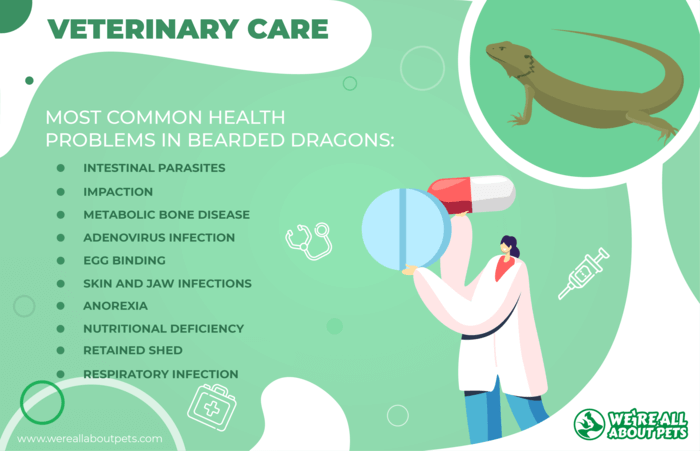
It’s always a good idea to have your new pet seen by a veterinarian within the first few weeks of bringing it home. This is important to establish a baseline for your pet’s health and wellness so your vet can bring your attention to potential health issues. From there, you’ll be better equipped to notice new symptoms and to keep up with necessary treatments.
Here are some of the most common health problems in bearded dragons:
- Intestinal parasites
- Impaction
- Nutritional Secondary Hyperparathyroidism (formerlyknown as Metabolic bone disease)
- Adenovirus infection
- Egg binding
- Skin and jaw infections
- Anorexia
- Nutritional deficiency
- Retained shed
- Respiratory infection
Your bearded dragon should receive a complete veterinary exam every 6 to 12 months and an annual fecal exam to check for parasites. Keep in mind that most veterinarians don’t treat bearded dragons – you may need to find an exotics or reptile veterinarian in your area.
Bearded Dragon Fun Facts
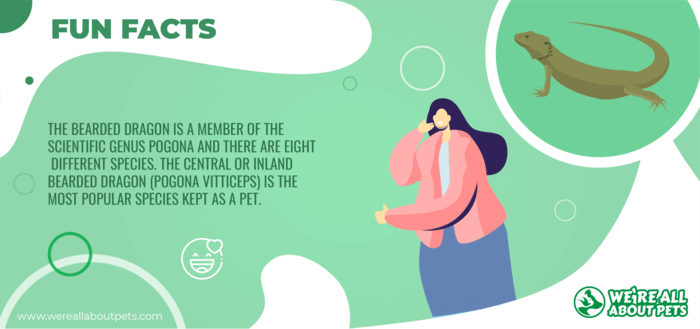
- The bearded dragon is a member of the scientific genus Pogona and there are eight different species. The central or inland bearded dragon (Pogona vitticeps) is the most popular species kept as a pet.
- Bearded dragons are diurnal animals that are active during the day but will often sleep in their burrow during the hottest part of the day. In the winter, wild bearded dragons will go into a hibernation-like state called brumation to conserve energy and body heat.
- The bearded dragon gets its name from the spines under the neck that resemble a beard. When they feel threatened, they can puff out the beard while opening the mouth to look larger.
- Adult bearded dragons are very territorial and will establish hierarchies in the wild. Both female and male bearded dragons exhibit head-bobbing behavior accompanied by darkening and flaring the beard as a demonstration of dominance.
- For the most part, bearded dragons are very sedentary animals, but they have the ability to run up to 9 miles per hour. In captivity, pet bearded dragons can be leash trained.
- Female bearded dragons will often lay eggs even if they haven’t been mated. The average clutch size is 18 to 24 eggs which are typically laid 4 to 5 weeks after breeding. The incubation period to hatch baby bearded dragons is about 60 to 80 days.
If you’re looking for a unique pet that has the potential to bond with you as an owner, the bearded dragon might be a good choice. Though they may look a little intimidating with their spiked bodies, beardies can actually become quite tame and they develop their own personalities.
As wonderful as bearded dragons are as pets, however, they do require a certain degree of care. Unless you’re able to provide for your new pet’s needs completely, consider another option.
Frequently Asked Questions
How long do bearded dragons live?
The average lifespan for a bearded dragon is about 8 to 15 years in captivity.
How much do bearded dragons cost?
The cost to keep a bearded dragon varies, particularly depending what species you choose. The classic bearded dragon you see at the pet store only costs around $50 while more exotic colorations or variations may cost $200 or more. Plan to spend as much as $300 to $500 on a tank with the necessary equipment.
How big do bearded dragons get?
Measured from nose to tail, the average adult bearded dragon size is 18 to 24 inches. These lizards generally weigh 10 to 18 ounces at maturity.
What do bearded dragons eat?
Bearded dragons are omnivores. In the wild, they’ll feed on a variety of insects and vegetation as well as fruits, flowers, and small vertebrates. In captivity, the diet should be about 30% to 45% prey items and the rest should come from fresh fruits and vegetables.
Are bearded dragons good pets?
Yes, bearded dragons (often affectionally nicknamed the beardie) are a great pet, especially for beginner reptile owners. These reptiles can be tamed with regular handling and they get along well with humans.
Are bearded dragons messy?
All pets have the potential to be messy, but bearded dragons are no worse than any other. In fact, you can approximate litter training if your bearded dragon develops a habit of using the same part of the tank to eliminate waste. For the most part, however, you’ll only need to do spot-cleaning to remove waste and leftover food on a daily basis with occasional more extensive cleaning.
Where do bearded dragons come from?
The bearded dragon (Pogona vitticeps) is native to Australia where it can be found in deserts, shrublands, and even eucalyptus woodlands.
Do bearded dragons bite?
Bearded dragons adapt well to captivity and can become quite tame. They generally do not bite, though any animal is prone to bite if it feels threatened or mistreated.
Do bearded dragons sleep?
Yes, bearded dragons are diurnal animals which means they are active during the day. They are, however, desert animals so they will often spend the hottest part of the day in their burrow.
How long are bearded dragons pregnant for?
Bearded dragons reach sexual maturity around 1 to 2 years. Females can lay eggs even if they haven’t been with a male. The average clutch size is 18 to 24 eggs which are typically laid 4 to 5 weeks after breeding. The incubation period to hatch baby bearded dragons is about 60 to 80 days.







